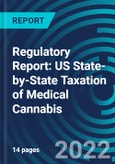Tax policies for medical cannabis vary widely across the states of the US, as the public policy debate continues. Whereas some states seek to derive revenue from it – either to fund tight regulation over the program or other endeavors – others subject medical cannabis to lower tax rates than other goods to reduce patients’ medical costs. By comparison, CBD products are generally taxed in the same way as any other sale of goods: they are subjected to the general state sales tax. Recreational cannabis, on the other hand, is often subject to excise taxes – sometimes at very high rates.
This report focuses only on state taxation of medical cannabis. On the federal level, there is no excise tax on cannabis, as it is a controlled substance. Cannabis businesses must still pay income taxes, though, and cannot claim deductions that other businesses routinely use for federal tax purposes.
This report focuses only on state taxation of medical cannabis. On the federal level, there is no excise tax on cannabis, as it is a controlled substance. Cannabis businesses must still pay income taxes, though, and cannot claim deductions that other businesses routinely use for federal tax purposes.
Table of Contents
1 Executive Summary 2 Introduction 3 State Taxation of Medical Cannabis 4 State Regulations 5 Alabama 6 Alaska 7 Arizona 8 Arkansas 9 California 10 Colorado 11 Connecticut 12 Delaware 13 Florida 14 Hawaii 15 Illinois 16 Louisiana 17 Maine 18 Maryland 19 Massachusetts 20 Michigan 21 Minnesota 22 Mississippi 23 Missouri 24 Montana 25 Nevada 26 New Hampshire 27 New Jersey 28 New Mexico 29 New York 30 North Dakota 31 Ohio 32 Oklahoma 33 Oregon 34 Pennsylvania 35 Rhode Island 36 South Dakota 37 Utah 38 Vermont 39 Virginia 40 Washington 41 West VirginiaSamples

LOADING...
Methodology
General Methodology/Sources
- Consumer and market participant (manufacturer/brand) surveys.
- Consolidation of publicly available information.
- Legal tracking through legal database checking and sourcing information from government regulators and other law-making bodies.
- Pricing and product information from online and offline retail data gathering, including local fieldwork teams.
- Findings from key industry events and interviews with leading market players and opinion leaders.
- Partnerships with leading research agencies.
- Quantitative and qualitative research and client collaborations.
- Cross-referenced data between markets.
- Tamarind Media proprietary market model.
Please note that each report has its own methodology, so you should always refer to the methodology applied in the report you purchase.

LOADING...








